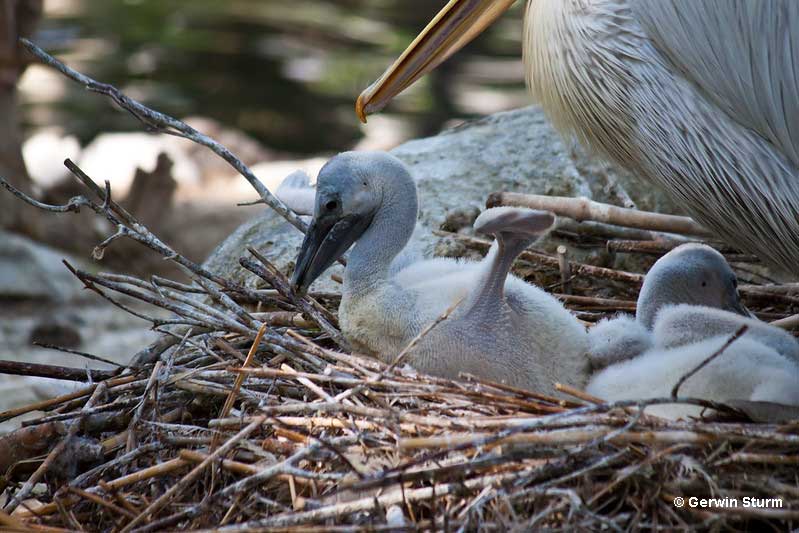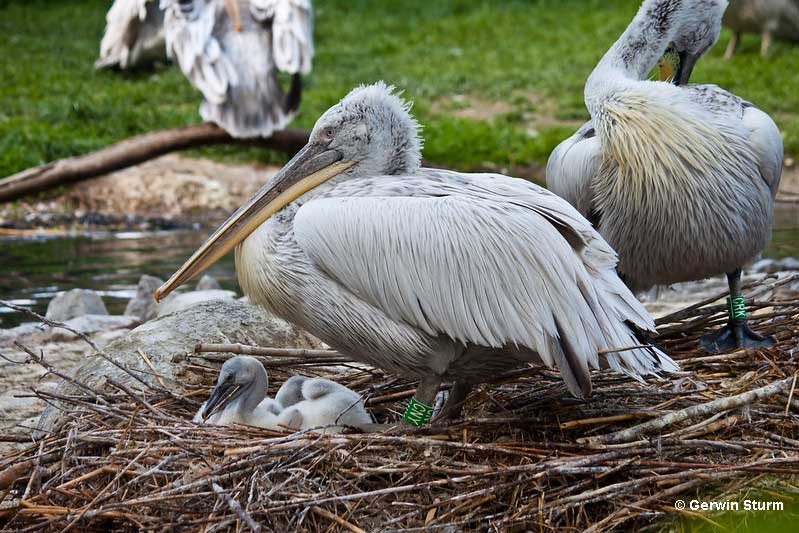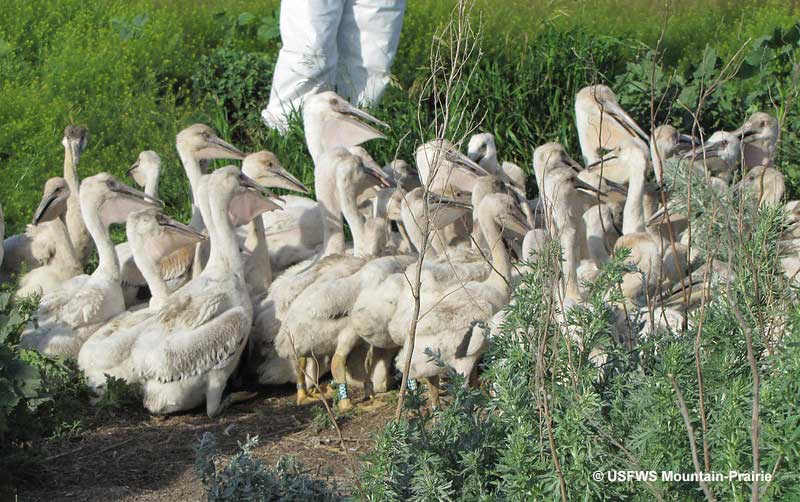
A baby pelican might be bigger than a baby robin but the young bird is just as helpless. Similarly to other baby birds, we don’t see baby pelicans very often.
Like most nestlings, their parents do everything possible to keep them from harm. Since baby birds are the definition of vulnerable, that includes keeping them out of sight and as far from predators as possible.
To keep nestlings out of harm’s way, many pelican nests are camouflaged and very difficult to see. Although we rarely get the chance to see baby pelicans in the nest, that doesn’t diminish their cuteness!
Learn all about cute and fuzzy baby pelicans in this post.
On this page
Nest
Depending on the species, pelicans can nest on the ground in a shallow scrape, or make a bulky, stick nest in a tree.
Pelicans lay two to four, chalky-white eggs. These big eggs can weigh 154 grams and are incubated by both parents for 30 days. While one parent goes foraging, the other takes care of the eggs and makes sure they have the right temperature.
When the feeding bird comes back after a day or two, they switch spots. After the babies hatch, the parent pelicans continue taking turns to accompany and brood the young for 17 days.
Baby pelicans eat regurgitated fish. The nestlings are entirely helpless and cannot feed themselves. Their parents regurgitate the food directly into the mouths of the babies and feed them four times a day. If a fish is too big for the baby to swallow, the parent usually eats it again.
After 17 to 20 days, baby pelicans leave the nest but stay in the colony to flock with other young pelicans.
By the 25th day after hatching, all baby pelicans in the colony flock together. This group of young pelicans is known as a “creche” and can include a dozen or more young birds.
They can walk around and swim but don’t feed themselves very often. After nine weeks, the young birds can fly but are still fed by their parents until they fly away from the colony, 11 weeks after hatching.
What Does A Baby Pelican Look Like?
When they come out of the egg, baby pelicans are naked and totally helpless. They weigh 110 grams, a big difference from their 16 pound parents! During the first hours after hatching, they have their eyes closed and can barely move.
However, later that same day or the next, they have some white down and raise their heads to take food. They grow quickly and by the end of the second week, are covered in thick, fuzzy gray down.
Related: Baby Birds – From Hatching to Adulthood
During the first few weeks of their lives, these young bids look like fuzzy, mini pelicans. They are chunky and have a long neck but don’t have any flight feathers.
The youngsters also have a pelican pouch and bill but these are much smaller than the huge beaks and pouches of their parents.
Baby pelicans are fed four times a day and are brooded by their parents for 17 days after hatching. By this time, baby pelicans can walk around and they leave the nest to join other young pelicans in the same colony.
They are still smaller than adults but after nine weeks, are similar in size. After fledging the young birds look like adults but have duller plumage and bills.
How To Tell Baby Pelicans Apart?
Baby pelicans look like miniature, white or gray, fuzzy versions of adult birds. Even when still in the nest, they have long beaks with pouches. There’s nothing they can be confused with except other pelican species. However, most pelican species nest in separate locations and aren’t found together.
By the time they leave the nest, they reach adult size and show more adult plumage. However, during their first year, most young pelicans look duller and grayer than adult birds. They also lack the bright colors shown on the bills and pouches of adult pelicans.
What Do Baby Pelicans Eat?
Baby pelicans have the same diet as their parents. This is a diet consisting of fish, bits of fish, and more fish! After hatching, adult pelicans feed regurgitated bits of fish and small fish to their babies.
They feed them this nutrient-rich concoction by placing their mouth directly over that of the baby bird and letting the food slide directly into the baby’s mouth. The baby pelican swallows the food whole.
Adults continue to feed the babies small fish but as the young birds grow, they switch to larger ones. The adults are capable of catching and eating large fish.
Related: What do baby birds eat?
Sometimes, they bring fish far too big for the baby to swallow. When that happens, the baby spits out the fish and the parent usually eats it again.
Frequently Asked Questions
What do you call a baby pelican?
A baby pelican is called a hatchling. When it can walk around, the baby pelican can also be called a toddler that forms a creche with other baby pelicans.
Are baby pelicans pink?
Baby Brown Pelicans are pink, but baby American White Pelicans are orange.
Why don’t we see baby pelicans?
Baby pelicans live in nesting colonies on islands and other inaccessible spots.
What do juvenile pelicans look like?
Juvenile pelicans resemble adults but have duller plumage and beaks.
Can baby pelicans fly?
No. Baby pelicans can’t fly until they are at least nine weeks old.




Lorraine Hall
Wednesday 17th of April 2024
Do you remember that old movie 'Animals are Beautiful People'?
It showed a bunch of adult pelicans flying south and they left their baby pelicans behind (who I guess were too young to fly). I think there was a drought as well.
Then a huge long line of young pelicans walked slowly together in the scorching sun until they dropped dead from exhaustion and thirst.
I want to know why this happened. Is this unusual?
Patrick O'Donnell
Monday 22nd of April 2024
@Lorraine- That probably doesn't happen too often. I would guess that it only happens in extreme circumstances where the adults laid eggs but the rains don't arrive in time.
Christie Seeley
Wednesday 20th of March 2024
How lovely to find your. Asking at such a. Early age AND act upon it. I spend a lot if time watching pelicans and the waves in Puerto Vallarta Mexico. It gives me much pleasure! My Best to you.
Patrick O'Donnell
Saturday 23rd of March 2024
@Christie- Pelicans and the waves at Puerto Vallarta- sounds pretty nice! Thank you for your comment.